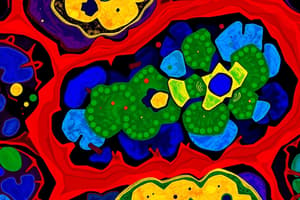Podcast
Questions and Answers
What areas are polymorphic in MHC Class I structure?
What areas are polymorphic in MHC Class I structure?
Alpha-2 and Alpha-3
What areas are polymorphic in MHC Class II structure?
What areas are polymorphic in MHC Class II structure?
Alpha-1 and Beta-1
MHC Class I structure is expressed on which cells?
MHC Class I structure is expressed on which cells?
All nucleated cells
MHC Class II structure is expressed on which cells?
MHC Class II structure is expressed on which cells?
What is the peptide size for MHC Class I?
What is the peptide size for MHC Class I?
What is the peptide size for MHC Class II?
What is the peptide size for MHC Class II?
What are the unique differences between MHC Class I antigen processing and MHC Class II processing?
What are the unique differences between MHC Class I antigen processing and MHC Class II processing?
What are the alternative pathways for antigen presenting?
What are the alternative pathways for antigen presenting?
What is cross presentation?
What is cross presentation?
Flashcards are hidden until you start studying
Study Notes
MHC Class I Structure
- Composed of an α chain with three MHC-encoded domains and β2-microglobulin (not encoded in MHC locus).
- Polymorphic regions: alpha-2 and alpha-3, which are the peptide binding domains.
MHC Class II Structure
- Composed of an α and a β chain, each with two structurally conserved, MHC-encoded domains.
- Polymorphic regions: alpha-1 and beta-1.
Cell Expression for MHC Class I
- Expressed on all nucleated cells, playing a crucial role in presenting antigens to CD8+ T cells.
Cell Expression for MHC Class II
- Expressed exclusively on antigen-presenting cells (APCs), including macrophages, dendritic cells, and B cells.
Peptide Size for MHC Class I
- Peptides are typically 8-11 amino acids long.
Peptide Size for MHC Class II
- Peptides are larger, ranging from 14-20 amino acids.
Differences in Antigen Processing
- MHC Class II processing involves an invariant chain that is degraded into CLiP in the Golgi vesicle before antigen loading.
- MHC Class I processing uses TAP1/TAP2 to transport peptides into the endoplasmic reticulum for loading onto MHC Class I.
- MHC Class I utilizes a proteasome for peptide cutting, while MHC Class II uses an endolysosome.
Alternative Pathways for Antigen Presentation
- Exogenous antigens can leak from endosomes to the cytosol and subsequently enter the MHC Class I pathway.
- Damage within the cell may lead to autophagy, routing these materials to the MHC Class II pathway via the MIIC compartment.
Cross-Presentation Mechanism
- B cells can express MHC Class I molecules, allowing them to present antigens to cytotoxic T cells.
- Antigens from infected cells are phagocytosed by APCs, processed, and loaded onto the APC's own MHC Class I, facilitating T-cell activation.
- This serves as an alternative mechanism to activate CD8+ T cells against foreign cells or antigens.
Studying That Suits You
Use AI to generate personalized quizzes and flashcards to suit your learning preferences.




